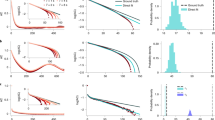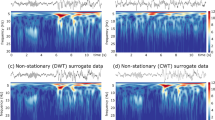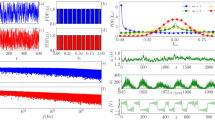Abstract
The need to characterize and forecast time series recurs throughout the sciences, but the complexity of the real world is poorly described by the traditional techniques of linear time-series analysis. Although newer methods can provide remarkable insights into particular domains, they still make restrictive assumptions about the data, the analyst, or the application1. Here we show that signals that are nonlinear, non-stationary, non-gaussian, and discontinuous can be described by expanding the probabilistic dependence of the future on the past around local models of their relationship. The predictors derived from this general framework have the form of the global combinations of local functions that are used in statistics2,3,4, machine learning5,6,7,8,9,10 and studies of nonlinear dynamics11,12. Our method offers forecasts of errors in prediction and model estimation, provides a transparent architecture with meaningful parameters, and has straightforward implementations for offline and online applications. We demonstrate our approach by applying it to data obtained from a pseudo-random dynamical system, from a fluctuating laser, and from a bowed violin.
This is a preview of subscription content, access via your institution
Access options
Subscribe to this journal
Receive 51 print issues and online access
$199.00 per year
only $3.90 per issue
Buy this article
- Purchase on Springer Link
- Instant access to full article PDF
Prices may be subject to local taxes which are calculated during checkout




Similar content being viewed by others
References
Weigend, A. S. & Gershenfeld, N. A. (eds) Time Series Prediction: Forecasting the Future and Understanding the Past (Santa Fe Inst. Studies in the Sciences of Complexity, Addison-Wesley, Reading, MA, (1993)).
Cleveland, W. S. & Devlin, S. J. Regression analysis by local fitting. J. Am. Stat. Assoc. 83, 596–610 (1988).
Wand, M. P. & Jones, M. C. Kernel Smoothing (Chapman & Hall, London, (1995)).
Fan, J. & Gijbels, I. Local Polynomial Modelling and Its Applications (Chapman & Hall, London, (1996)).
Fan, J. & Gijbels, I. Data-driven bandwidth selection in local polynomial fitting: variable bandwidth and spatial adaptation. J. R. Stat. Soc. B 57, 371–394 (1995).
Jordan, M. I. & Jacobs, R. A. Hierarchical mixtures of experts and the EM algorithm. Neural Comput. 6, 181–214 (1994).
Weigend, A. S., Mangeas, M. & Srivastava, A. N. Nonlinear gated experts for time series: discovering regimes and avoiding overfitting. Int. J. Neural Syst. 6, 373–399 (1995).
Ghahramani, Z. & Jordan, M. I. in Advances In Neural Information Processing SystemsVol. 6 120–127 (MIT Press, Cambridge, MA, (1995)).
Lei, X., Jordan, M. I. & Hinton, G. E. in Advances in Neural Information Processing SystemsVol. 7 633–640 (MIT Press, Cambridge, MA, (1995)).
Waterhouse, S., MacKay, D. & Robinson, T. in Advances in Neural Information Processing SystemsVol. 8 351–357 (MIT Press, Cambridge, MA, (1996)).
Farmer, J. D. & Sidorowich, J. J. Predicting chaotic time series. Phys. Rev. Lett. 59, 845–848 (1987).
Sauer, T. in Time Series Prediction: Forecasting the Future and Understanding the Past (eds Weigend, A.S. & Gershenfeld, N. A.) 175–193 (Santa Fe Inst. Studies in the Sciences of Complexity, Addison-Wesley, Reading, MA, (1983)).
Gershenfeld, N. A. The Nature of Mathematical Modeling (Cambridge Univ. Press, (1999)).
Gershenfeld, N. A. & Grinstein, G. Entrainment and communication with dissipative pseudorandom dynamics. Phys. Rev. Lett. 74, 5024–5027 (1995).
Dempster, A. P., Laird, N. M. & Rubin, D. B. Maximum likelihood from incomplete data via the EM algorithm. J. R. Stat. Soc. B 39, 1–38 (1977).
Wahba, G. & Wold, S. A. Completely automatic French curve: fitting spline functions by cross validation. Commun. Stat. 4, 1–17 (1975).
Richardson, S. & Green, P. J. On Bayesian analysis of mixtures with an unknown number of components. J. R. Stat. Soc. B 59, 731–792 (1997).
Hüebner, U., Weiss, C. -O., Abraham, N. & Tang, D. in Time Series Prediction: Forecasting the Future and Understanding the Past (eds Weigend, A. S. & Gershenfeld, N. A.) 73–105 (Santa Fe Inst. Studies in the Sciences of Complexity, Addison-Wesley, Reading, MA, (1993)).
Casdagli, M. in Nonlinear Modeling and Forecasting (eds Casdagli, M. & Eubank, S.) 265–281 (Santa Fe Inst. Studies in the Sciences of Complexity, Addison-Wesley, Redwood City, CA, (1992)).
Stark, J., Broomhead, D. S., Davies, M. E. & Huke, J. Takens embedding theorems for forces and stochastic systems. Nonlinear Anal. 30, 5303–5314 (1997).
Buntine, W. L. Operations for learning with graphical models. J. Artif. Intelligence Res. 2, 159–225 (1994).
Smyth, P., Heckerman, D. & Jordan, M. I. Probabilistic independence networks for hidden Markov probability models. Neural Comp. 9, 227–269 (1997).
Acknowledgements
We thank C. Douglas, C. Cooper, R. Shioda and E. Boyden for help with the collection and analysis of the violin data. This work was supported by the Things That Think consortium of MIT Media Laboratory.
Author information
Authors and Affiliations
Rights and permissions
About this article
Cite this article
Gershenfeld, N., Schoner, B. & Metois, E. Cluster-weighted modelling for time-series analysis. Nature 397, 329–332 (1999). https://doi.org/10.1038/16873
Received:
Accepted:
Issue Date:
DOI: https://doi.org/10.1038/16873
This article is cited by
-
Generative learning for nonlinear dynamics
Nature Reviews Physics (2024)
-
Matrix Normal Cluster-Weighted Models
Journal of Classification (2021)
-
Assessing trimming methodologies for clustering linear regression data
Advances in Data Analysis and Classification (2019)
-
Robust estimation of mixtures of regressions with random covariates, via trimming and constraints
Statistics and Computing (2017)
-
The Generalized Linear Mixed Cluster-Weighted Model
Journal of Classification (2015)
Comments
By submitting a comment you agree to abide by our Terms and Community Guidelines. If you find something abusive or that does not comply with our terms or guidelines please flag it as inappropriate.



